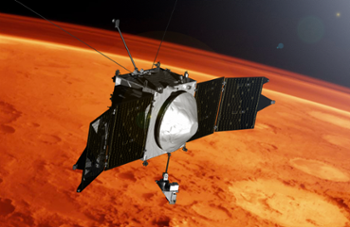Dr. Minton leading team to design spacecraft to study Mars moons
03-28-2017
Writer(s): Logan Judy

A Purdue team, led by Dr. David Minton, will design a spacecraft for NASA to investigate the moons of Mars.
The project, named “Chariot to the Moons of Mars,” was one of only 10 out of 102 proposals selected for NASA’s Planetary Science Deep Space SmallSat program. The team, which also includes Dr. Briony Horgan of EAPS and Dr. David Spencer of Aeronautical and Astronautical Engineering, will enable NASA to eventually utilize technology optimized for the moons of Mars, Phobos and Deimos. The only spacecraft currently being used to study these two moons are those designed for the study of Mars itself. They can only occasionally capture images when the conditions are just right, and the instruments are designed for Mars, not the moons of Mars. For Phobos and Deimos, a different design approach will be required.
“We would like to eventually take what we learn in our spacecraft design study and build a real spacecraft to go visit Phobos and Deimos,” Dr. Minton said. “The unique thing about the NASA program that is funding us, is that they were looking for proposals for very small spacecraft, much smaller than most planetary science missions. There are unique challenges when designing these small spacecraft, and so far none of these small class of spacecraft have flown beyond Earth orbit. But there also opportunities involved. Miniaturization technology is allowing such small spacecraft to become feasible.”
Once NASA is able to get a spacecraft to Phobos and Deimos, this will help scientists to understand more about moons. Out of the four terrestrial planets, only Earth and Mars have moons, and according to Dr. Minton, the moons of Mars provide a lot of learning opportunities.
“Earth’s moon is very large, and is almost a planet itself,” Dr. Minton said. “The two moons of Mars are very small and very different than the Earth’s moon. We don’t really understand how Mars got these moons, and we’d like to find out. Also, we would like to investigate what kind of resources might be available on these moons that could be used by future explorers on Mars. We don’t know what they are made of, so we don’t know what kind of useful resources might be available.”
The team also includes researchers from Arizona State University, the University of Illinois at Urbana-Champaign, and Tyvak, Inc.